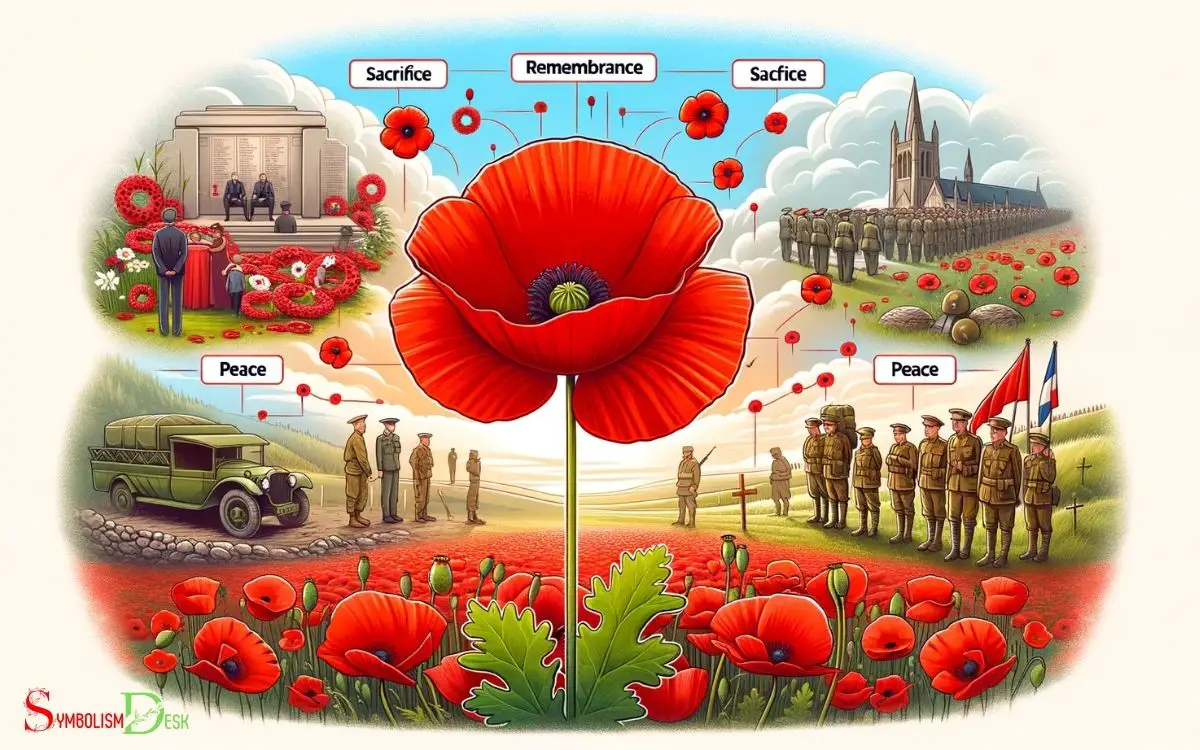What is the Symbolic Meaning of a Poppy? Peace!
The poppy flower symbolizes remembrance, peace, and death, as well as sleep and resurrection. It is widely recognized for its association with World War I and is used during Remembrance Day commemorations.
The symbolic meaning of the poppy flower encompasses several themes:
- Remembrance: Since World War I, red poppies are worn to honor fallen soldiers, especially on Remembrance Day, due to the flower’s proliferation on European battlefields.
- Peace: The poppy also represents a desire for peace after conflict.
- Death: Its connection to battlefields has made it a symbol of death and a marker of sacrifice.
- Sleep and Resurrection: In Greek and Roman myths, poppies were associated with sleep, due to the sedative effect of their opium content, and with resurrection because they are perennial plants.
Poppies carry a poignant message of sacrifice and hope, eternally linked to the valor of those who have served in armed conflicts.

Key Takeaway
5 Colors: Symbolic Meanings of a Poppy
| Color | Symbolic Meaning |
|---|---|
| Red | Remembrance, particularly of soldiers who gave their lives during wartime |
| White | Peace, rest, and consolation |
| Purple | Honoring animals that have been casualties in war |
| Yellow | Wealth and success |
| Black | Death, loss, and mourning |
Historical Significance of the Poppy
The historical significance of the poppy dates back to ancient civilizations, where it was used as a symbol of remembrance and resilience. In ancient Greek and Roman mythology, the poppy was linked to messages of sleep, death, and resurrection.
The symbolism of the poppy as a representation of remembrance can be traced to the Napoleonic wars, where fields of poppies bloomed across the battlefields.
This connection was further popularized by the famous World War I poem, ‘In Flanders Fields,’ which described the poppies growing amidst the graves of fallen soldiers.
The resilient nature of the poppy, able to bloom in disturbed and war-torn fields, made it an apt symbol for the endurance of the human spirit in the face of adversity.
This historical context sets the stage for understanding the poppy as a symbol of remembrance.
The Poppy as a Symbol of Remembrance
Symbolizing remembrance, the poppy holds historical significance as a resilient emblem of endurance and commemoration, rooted in ancient mythology and further popularized by its presence on battlefields.
The poppy’s association with remembrance stems from the aftermath of World War I when the flowers bloomed across the war-torn fields of Flanders.
Lieutenant Colonel John McCrae’s iconic poem ‘In Flanders Fields’ immortalized the poppy as a symbol of sacrifice and remembrance for fallen soldiers.
The red poppy serves as a poignant reminder of the human cost of war and is used to honor and remember military personnel who’ve died in the line of duty.
Today, the poppy is worn or displayed during memorial events, serving as a powerful symbol of gratitude and respect for those who’ve made the ultimate sacrifice.
Poppies in Art and Literature
Poppies have been a recurring motif in art and literature, often symbolizing themes of life, death, and renewal. They’ve captured the imagination of artists and writers for centuries, inspiring diverse interpretations and representations.
In art and literature, poppies are used to convey various meanings:
- Symbol of Sleep and Peace: Poppies are often associated with sleep and peace due to their connection with opium and its sedative properties.
- Representation of Remembrance: In war literature and art, poppies are used to symbolize the memory of fallen soldiers and the sacrifices of war.
- Metaphor for Transience: Poppies are employed to depict the fleeting nature of life and the inevitability of death.
- Sign of Rebirth and Hope: Poppies also serve as a symbol of renewal, regeneration, and hope for the future, particularly after periods of devastation and loss.
Cultural and Religious Symbolism
Cultural and religious symbolism of poppies extends across various societies and faith traditions, each imbuing the flower with unique significance.
In many cultures, the red poppy is a symbol of remembrance for those who’ve died in war, and it’s often worn on Memorial Day or Remembrance Day.
In Christianity, the poppy is associated with both death and resurrection, representing the eternal cycle of life, death, and rebirth.
In Greek and Roman mythology, poppies were linked to sleep, peace, and death.
In Eastern cultures, the poppy holds various meanings, including prosperity, success, and the beauty of life.
The diverse interpretations of the poppy in different cultures and religions showcase its enduring and multifaceted symbolic importance.
Contemporary Meaning and Impact
A significant number of people today wear poppies as a symbol of remembrance for those who’ve died in war. The contemporary meaning and impact of the poppy as a symbol are profound and continue to evolve.
Poppies serve as a visual reminder of the human cost of war, fostering awareness and reflection on the sacrifices made.
The collective act of wearing poppies creates a sense of unity and solidarity among individuals honoring veterans and fallen soldiers.
Funds raised through poppy sales provide essential support for veterans and their families, addressing their unique needs and challenges.
Social media campaigns and public events centered around the poppy symbol amplify its significance, keeping the conversation about war, peace, and remembrance relevant in modern society.
Conclusion
As the petals of the poppy bloom to reveal a vibrant red hue, they also unfurl a story of sacrifice, remembrance, and resilience.
The poppy serves as a powerful allegory for the enduring human spirit in the face of adversity, reminding us to honor the past, cherish the present, and strive for a peaceful future.
Its symbolic meaning transcends time and culture, weaving a tapestry of hope and unity in its delicate petals.






